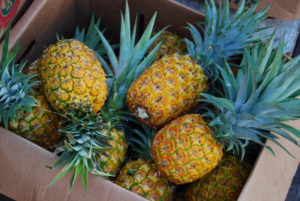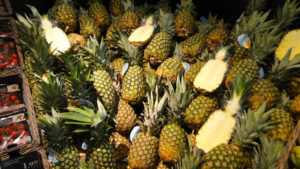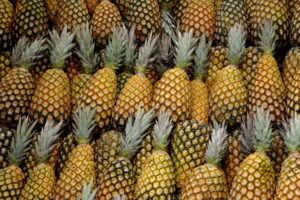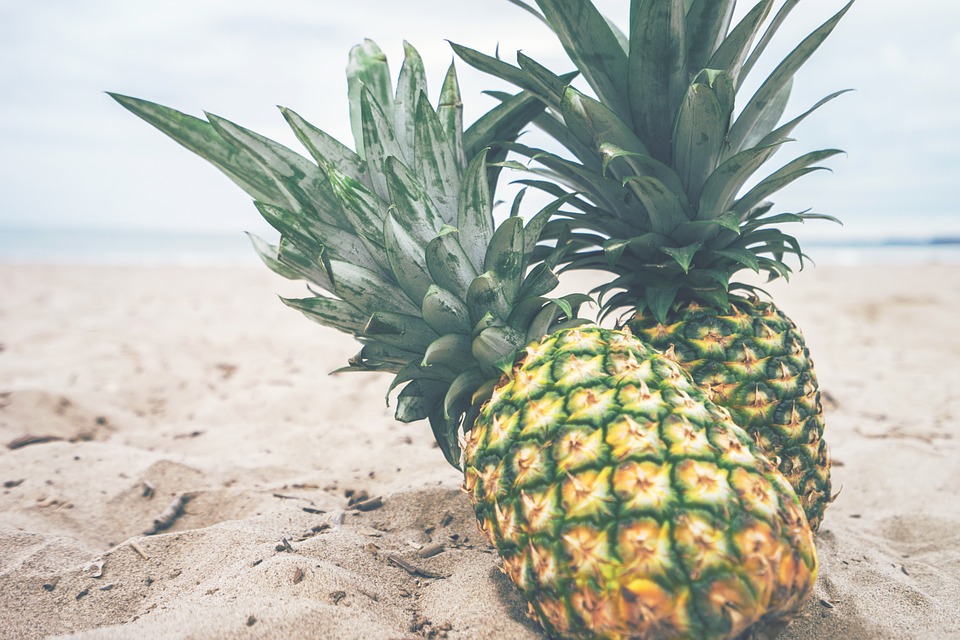The pineapple is a tropical plant with an edible multiple fruit consisting of coalesced berries, which are also called pineapples, and the most economically significant plant in the Bromelaceae family. Take a look below for 26 more fun and interesting facts about pineapples.
1. Pineapples can be cultivated from a crown cutting of the fruit, possibly flowering in 5 to 10 months and fruiting in the following 6 months.
2. Pineapples don’t ripen significantly after harvest.
3. In 2016, Costa Rica, Brazil and the Philippines accounted for nearly one-third of the world’s production of pineapples.
4. Pineapple leaves are used to produce the textile fiber “pina” in the Philippines, which is commonly used as the material for the men’s “barong Tagalog” and women’s “baro’t saya” formal wear in the country.

5. The word “pineapple” in English was first recorded to describe the reproductive organs of conifer trees, which are now called pine cones.
6. Pineapples are indigenous to South America, specifically the area between southern Brazil and Paraguay. However, not much is known about the origin of the domesticated pineapple.
7. The native of southern Brazil and Paraguay spread the pineapple throughout South America, and it eventually reached the Caribbean, Central America, and Mexico, where it was cultivated by the Mayas and the Aztecs.
8. Columbus encountered pineapples in 1493 on the leeward island of Guadeloupe, he called it “pina de Indies” meaning “pine of the Indians.”
9. The pineapple was brought to northern Europe by the Dutch from their colony in Surinam.
10. The first pineapple to be successfully cultivated in Europe, is said to have been grown by Pieter de la Court at Meerburg in 1658.

11. In France, King Louis XV was presented with a pineapple that had been grown at Versailles in 1733.
12. Catherine the Great ate pineapples grown on her own estates before her death in 1796.
13. Pineapple plants can reach 3.3 to 4.9 feet in height. The biggest specimens of the fruit can reach nearly 20 pounds in weight.
14. Pineapples are perennial herbaceous plants that have a short and stocky stem. Their leaves are spiny and covered with wax on the surface.
15. Pineapple is actually a result of 100 to 200 individual flowers fusing together.
16. The color of a pineapple depends on the variety, but it can be red, purple or lavender in color.

17. Two types of pineapples, the cayenne pineapple and the red Spanish pineapple, are currently cultivated and consumed throughout the world. The two differ in both color and size.
18. One plant produces only one pineapple per season.
19. Almost all parts of the pineapple can be used in the production of vinegar and alcohol. Inedible parts can be used as food for domestic animals.
20. The world’s largest pineapple ever recorded was in 2011, grown by Christina McCallum from Bakewell, Australia. The pineapple was 32 centimeters long, with a 66 centimeter girth and weighed 8.28 kilograms.
21. 75% of all pineapples sold in Europe are grown entirely in Costa Rica.
22. The Dole Plantation’s Pineapple Garden Maze in Hawaii has the record for the largest maze in the world; it stretches over three acres.

23. Pineapples had a mysterious aura in the Age of Sail because, aside from the small elite with access to glass hothouses, tropical fruits could only be eaten where they were cultivated.
24. In architecture, pineapple figures are a decorative element symbolizing hospitality.
25. In the wild, pineapples are primarily pollinated by hummingbirds. However, certain wild pineapples are foraged and pollinated at night by bats.
26. Pineapple contains bromelain, a substance which decomposes proteins and facilitates digestion. People can use marinade made of pineapple juice to reduce toughness of the meat.




